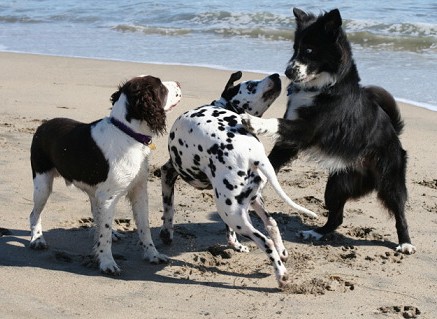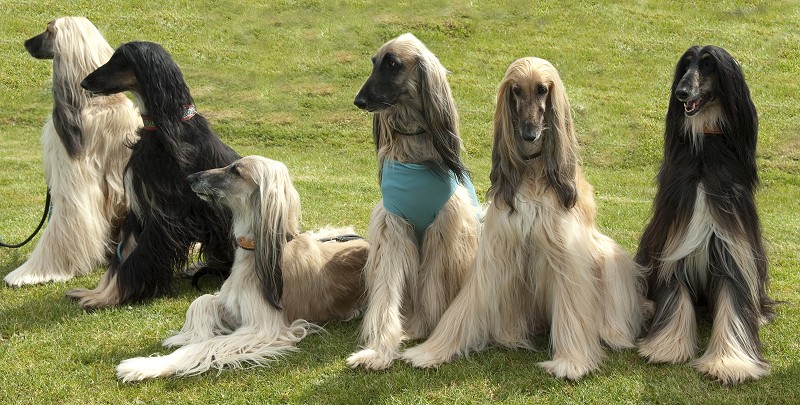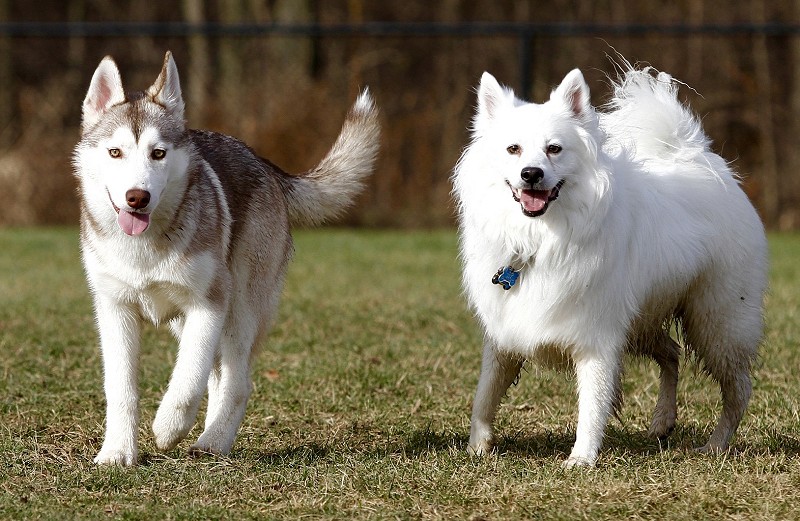Living with multiple dogs
By Michele Welton, Dog Trainer, Breed Selection Consultant, Author of 15 Dog Books
Suppose you already have a dog, or several dogs, and you bring home a new puppy.
A multi-dog household can be one of the easiest – or most difficult – environments in which to raise and train a new puppy. So much depends on what your other dogs are like!

If your other dogs are calm, well-behaved, and respectful of you and of each other....
...congratulations! You've succeeded in establishing the right social dynamic, and a new puppy is likely to follow and adopt their behavior. In essence, the other dogs will demonstrate, through their body language and attentiveness to you, that they respect YOU as the leader. The new pup is likely to copy them and do the same thing.
But if your other dogs have behavioral issues....
if they jump on people, bicker with each other, aren't 100% housebroken, or only listen to you when they feel like it.... well, a new puppy is likely to follow unruly dogs into misbehavior. You should have waited until you succeeded in establishing the right relationship with your existing dogs first.
But if you've already done it, if you've brought home a new puppy and you have other dogs who aren't behaving, I strongly advise you to spend as much time working with those other dogs as you spend working with the new one.
Pups follow the behavior of other dogs, you see. When the current dogs are misbehaving, expect the new pup to do the same.
Dog-on-dog aggression
My fellow trainers and I are frequently called into multi-dog households that are in chaos due to bickering, bullying, jealousy, or downright aggression.
This all happens because dogs are sociable animals. When they join our family, they seek to find out its structure. Who are the leaders and who are the followers?
Introducing a new pup into an established canine group changes the existing group dynamic. Sometimes, fortunately, the dogs are so good-natured that there are no issues. Sometimes there are minor issues. And sometimes major fights occur when the dogs disagree about the new pecking order.
Now, while the new dog is still a young puppy, fights rarely occur because most adult dogs are tolerant toward a young puppy.

When you have multiple dogs, you need to monitor and manage their interactions, which means you should be able to "read" your dogs' body language.
But as the pup matures, his hormones begin changing, which typically triggers some behavior changes. Then one or more of the other dogs will notice. "Oh-oh, things are different! Which dogs can I pick on now? Which dogs are going to pick on me? Who's in charge here?"
Then all hell may break loose.
Dog-on-dog aggression within a family can be one of the most difficult behavior problems to solve because it requires a particular kind of owner who can "read" dogs accurately and recognize the (sometimes subtle) signs of a pending confrontation.
Sometimes two warring dogs must be kept separated forever, or one of them re-homed, preferably into a household with no other dogs.
How to avoid problems in multi-dog households
Rule #1: All of your dogs must act as equals.
No dog should be allowed to dominate any other dog. The only one in charge is YOU (and the other adult humans).
Forget ideas like "letting the dogs work it out" or allowing bullying because "He's the boss of the other dogs."
 YOU are the only one who should be the boss. All of your dogs should conduct themselves as equals. Whether you have two dogs or ten, they're equals. If any dog tries to take advantage of another dog, you step in right away and stop it.
YOU are the only one who should be the boss. All of your dogs should conduct themselves as equals. Whether you have two dogs or ten, they're equals. If any dog tries to take advantage of another dog, you step in right away and stop it.
Don't allow one dog to pester another. Often a puppy will persistently try to play with an older dog who is trying to sleep. Puppies should not be free to wander around the house pestering other dogs.
Don't allow one dog to take anything away from another. That includes toys, food, and beds. If a dog is chewing peacefully on a toy, or eating his food, or sleeping on a dog bed, the other dogs must not try to take it away or intimidate the first dog away from it.
You need to protect every dog from being jumped on, chased, teased, bullied, or simply overwhelmed by children or other pets. Trust me, dogs notice when you step in and stop the jumping, chasing, bullying, etc. They also notice when you just sprawl in a chair watching TV and fail to keep them safe.

Don't allow any dog to discipline another dog. That's your job. If a dog is chewing on a toy and another dog tries to take it away and the first dog lunges to fight, you should discipline BOTH dogs. Put the toy away and send both dogs to their crates or to different dog beds ("Go to your bed").
The only time I relax this rule that "I am the only one who disciplines" is when I have a wise and well-behaved older dog who is excellent at keeping the younger dogs from being pests.
For example, suppose a puppy is going overboard trying to incite another dog to play when the other dog clearly doesn't want to. Before I can get over there to stop the puppy, my wise older dog might step in with a growl or snap, perhaps even making the puppy yelp but not harming him.
This is a canine social signal which is important for Puppy to understand. So I don't discipline the older dog – hopefully he taught Puppy a valuable lesson.
Still, you don't want this to become a pattern. If Puppy doesn't get the message, if instead he goes right back to pestering, put him on a leash or in his crate or pen, before things escalate and he gets seriously bitten... and then you would need to discipline the older dog, as well.
Summary of Rule #1: All of your dogs must act as equals.
Rule #2: All of your dogs must get equal time and attention.
 When you first see your dogs in the morning, or after coming home from work or shopping, greet them individually by name.
When you first see your dogs in the morning, or after coming home from work or shopping, greet them individually by name.
Look at each dog as you give him an affectionate pat or a quick rub of his head and ears. Then move on to the next dog.
Since dogs love patterns, I always greet (and feed) my dogs in the order I got them. The dog who has lived with me the longest gets the first greeting, and the newest dog gets the last greeting.

Jealous behavior is not allowed. If you're petting one dog, another dog may FEEL jealous (feelings are feelings, after all) but he may not act out that feeling. If a dog is pushy and tries to shove his way forward for more petting, or for petting out of turn, keep your hands off him and ignore him until last. Then have him "Sit" before he gets his attention.
Also try to make time for all of your dog(s) as individuals. Take one dog for a walk – just the two of you. Take one dog to the basement for 10 minutes of brushing – just the two of you. Play a quick game of fetch with just one dog.
Just make sure you are the one making the decisions about who gets attention and when. Don't let the dogs themselves demand it. It's a subtle leadership thing!
My best-selling books – now available FREE on my website
 Respect Training For Puppies: 30 seconds to a calm, polite, well-behaved puppy is for puppies 2 to 18 months old. Your puppy will learn the 21 skills that all family dogs need to know. Click here to read for free.
Respect Training For Puppies: 30 seconds to a calm, polite, well-behaved puppy is for puppies 2 to 18 months old. Your puppy will learn the 21 skills that all family dogs need to know. Click here to read for free. Teach Your Dog 100 English Words is a unique Vocabulary and Respect Training Program that will teach your adult dog to listen to you and do what you say. Click here to read for free.
Teach Your Dog 100 English Words is a unique Vocabulary and Respect Training Program that will teach your adult dog to listen to you and do what you say. Click here to read for free. 11 Things You Must Do Right To Keep Your Dog Healthy and Happy helps your dog live a longer, healthier life. Get my honest advice about all 11 Things before you bring home your new puppy, because some mistakes with early health care cannot be undone. Click here to read for free.
11 Things You Must Do Right To Keep Your Dog Healthy and Happy helps your dog live a longer, healthier life. Get my honest advice about all 11 Things before you bring home your new puppy, because some mistakes with early health care cannot be undone. Click here to read for free.
